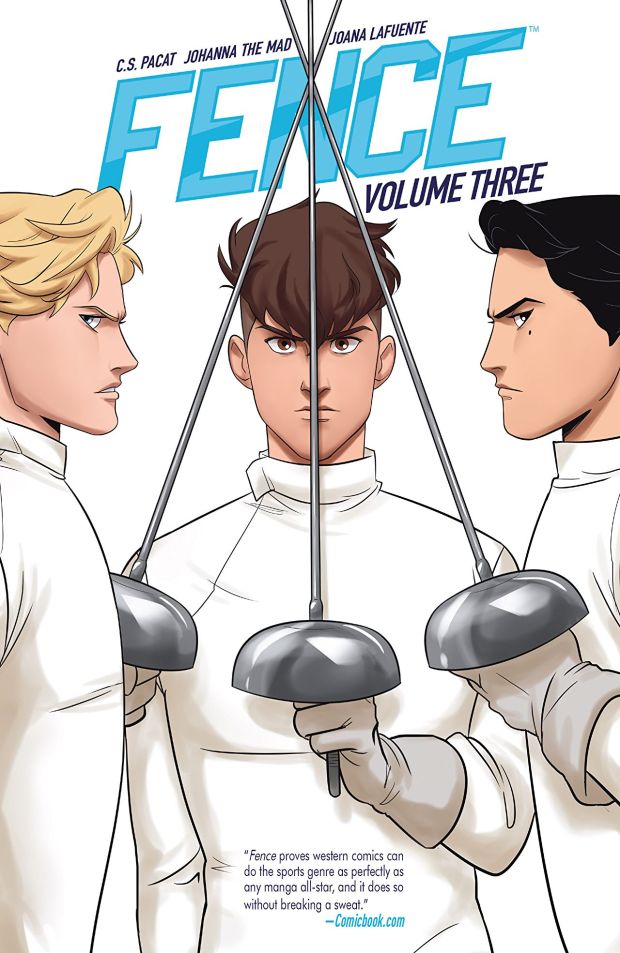by CS Pacat, Johanna the Mad, Joana LaFuente, and Jim Campbell
volume one | two | three | four
At the end of Fence’s third volume I said I wouldn’t be sticking around for volume four – and yet, here we are. I hoped things would improve, and part of me – begrudgingly – sees potential in the characters, intense dedication to fencing, and not so subtle queerness of most, if not all, of the boys on the King’s Row fencing team.
This chapter is more of the same, on all counts – even though this is the first volume published as a graphic novel instead of monthly issues. So if you loved the first three volumes, there’s no doubt you’ll enjoy this one too. The championship tournament has begun, and Nicholas and team are facing MLC – the team that knocked out King’s Row last year. Will the team come together in a sport that focuses on individual matches?
You’d hope that four volumes in we were past the exposition of the sport, but now we’re in Tournament Mode and there are More Rules to learn! Yippee! Not really, my eyes glazed over as the coach and other characters yammered before and between matches about the point system, tournament matchups, and player order – and it really wasn’t necessary. Some footnotes in the back would have been preferable; if I was reading Fence to learn about fencing, I’d read a Wikipedia article instead. And once again, the rest of the book is just one match. For all its focus on a sport that values precision and agility (according to all the rules I’ve learned), Fence continues to move at a glacial pace. If you don’t care about the characters, you won’t make it to this volume.
Granted, this chapter does a better job of balancing fencing with character development, even though it’s spread pretty thin among the whole team (but not the coach), while focusing on Nicholas and Seiji’s “friendship” which will obviously turn into something more (more on that in a second). There is a clearer goal in this volume (for the boys to come together as a team) and higher stakes (losing the tournament) that really lends itself much better to growth than before.
There are also a *lot* more queer references and even coded language in the fencing dialogue itself (see below), and I can’t tell whether dancing around it is a positive thing or not. In other words, every relationship is a “will-or-won’t-they” slow burn, and I’m not sure if living solely in that tension translates to a positive queer story. Whether or not it’s good, it does fit several tropes about queer and sports books (see here), so folks familiar with one or both genres know what to expect.

Finally, Johanna the Mad continues as Fence’s artist, and while his style is largely the same, there’s a different kind of fluidity to his art. I’m not well versed enough in art to pinpoint exactly what it is, but it feels different, and honestly I can’t tell whether it’s an improvement or not. It’s possible that publishing this volume as one graphic novel altered his schedule, giving him more or less time. Regardless, there were definitely a few panels that looked rushed.
I’m still not sure where I stand on Fence. You might say I’m on the – nope, can’t do it. I’m sorry. It’s clearly very popular (Fence now has a novel adaptation*), and maybe I’m just not that demographic. Fence has enough potential to reel me back in, but seems to be set in its ways, but because it could be more well rounded, focused on character, and committed to being a queer positive book, I feel like my time would be better spent reading something else.
*I was about to to write ‘you couldn’t pay me to read it,’ but on second thought….yes, yes you could.








